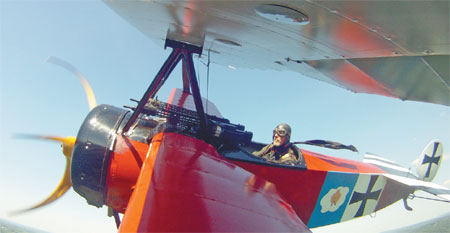WWI aviation lives on at aerodrome
There's still a place where biplanes swoop in pursuit of German triplanes, where pilots in open cockpits let their scarves flutter in the wind.
The sights and sounds of World War I flight are recreated regularly at the Old Rhinebeck Aerodrome in New York's Hudson Valley, where an original Curtiss JN-4H "Jenny" - a key US warplane - shares the sky with reproductions of a French Spad VII and German Fokkers.
"I get to shoot down a Fokker triplane every Sunday afternoon," said air show director Chris Bulko, who flew the Spad. "I call it playing with the toys here and sharing them with everybody else, and inviting them into our sandbox."
The aerodrome, located 80 miles north of New York City, is one of the scattered places around the world that puts on air shows based on World War I, which began July 28, 1914. The attraction also boasts a museum and hangars packed with planes dating from the dawn of flight to World War II. But the weekend air shows are what draw the big crowds. Saturday shows highlight the early history of aviation. Sundays are devoted to the Great War.
Men dressed in oldtime overalls start balky engines with hard pulls on propellers. Bulko blows kisses to the crowd on takeoff and chases a doppelganger of the Fokker triplane piloted by Manfred von Richthofen (the Red Baron). No machine guns are here, although pilots show off their skills by flying through falling streams of toilet paper.
Back on the ground, a melodrama plays out involving Sir Percy Goodfellow, Trudy Truelove and scheming villains. It's family entertainment that harks back to a perilous period.
Flying could be deadly for young pilots, some of whom were teenagers. Planes were wood-framed, fabric-covered and flammable. Enemy pilots attacked with the sun behind them to blind their prey, sometimes braving barrages of anti-aircraft fire. Machine guns jammed. There were no parachutes.
"It's a dangerous business simply because the planes are not reliable in many respects. They are also sometimes difficult to fly," said John H. Morrow Jr, an expert in WWI aviation who teaches history at the University of Georgia.
Many of the planes that made it through the war were destroyed as surplus, a big reason why originals are so rare.
Aerodrome founder Cole Palen bought a few old planes in 1951 when a Long Island hangar at the site of Charles Lindbergh's trans-Atlantic takeoff made way for a shopping plaza. Palen collected pre-WWII planes for the rest of his life and reproduced hard-to-find historical planes, usually with original engines.
|
David King pilots a War War I-era Fokker DR-1 reproduction triplane during an air show at the Old Rhinebeck Aerodrome in Rhinebeck, New York, on July 6. Mike Groll / AP |



















